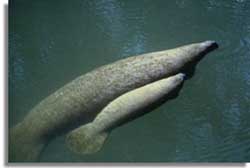|
|
|
January 9, 2007
 |
| Photo by Doug Perrine,
USFW © |
A preliminary report from the Florida Fish and Wildlife Conservation
Commission (FWC) says there were 416 manatee deaths in state waters in
2006. That compares to 396 in 2005.
Scientists are unsure whether the increase reflects manatee population
growth, increased mortality or better detection of carcasses. However, the
best available science indicates that Florida’s manatee population is
stable or growing in all regions of the state except the Southwest, which
may contain more than a third of the statewide population.
The FWC report indicates watercraft-related mortalities and red tide
contributed to more than half of the total deaths in 2006 in instances
where scientists could determine the cause of death.
Researchers classify manatee mortalities in eight categories – watercraft,
floodgate/lock, other human, perinatal (newborn), cold stress, other
natural, undetermined and unrecovered carcasses. The number of manatee
deaths declined in every category except watercraft, undetermined and
unrecovered.
“It is always sad to see such high numbers, especially in watercraft-caused
mortality, but these numbers shed some light on the measures we can take in
our commitment to reducing human-related threats to manatees and possibly
other threats,” said FWC Chairman Rodney Barreto. “With continued human
population growth and enjoyment of the outdoors, we must all be diligent in
the conservation and protection of this gentle animal.”
FWC scientists report that red tide continues to threaten manatees in
Southwest Florida, with 37-96 deaths annually in four of the past five
years. Preliminary findings suggest red tide may have been responsible for
the deaths of 61 manatees in 2006.
The 86 watercraft-related manatee deaths in 2006 are the second highest on
record for that category. As a result, FWC law enforcement will enforce a
special manatee speed zone detail this weekend. The FWC is urging boaters
to abide by manatee speed zones and assuring law-abiding boaters who hit
manatees that they will not receive citations if they report such
accidents. Accident reports provide valuable information for sharpening
manatee protection efforts.
“The FWC’s seizing every option in helping manatees continue to recover,”
Barreto said. “We’ll be exploring other options to ensure recovery stays on
track.”
For instance, manatee mortality figures provide useful information on why
manatees die and the risks they face. Information from necropsies
(non-human autopsies) help FWC scientists develop conservation measures to
reduce risks to manatees. One such measure is development of the state’s
first manatee management plan.
The draft plan (PDF file; Adobe Reader required), which is available for
public comment, examines past protections and outlines additional measures
such as protection of warm-water refuges to reduce stress on manatees
during the winter. It also proposes new measurable biological goals and
objectives that will provide benchmarks and timelines to help guide future
management decisions.
The number of manatees for which a cause of death could not be determined
because of decomposition of carcasses was unusually high in 2006,
representing 37 percent or 155 of the total.
“Every year a substantial portion of deaths cannot be attributed to a
specific cause because of the advanced decomposition of the carcasses,”
said FWC research scientist, Leslie Ward.
Scientists use population models to estimate manatee population growth.
Although the most recent analysis indicates manatee numbers have been
stable or growing in many parts of the state, some areas may require more
attention.
“The FWC is aware of that,” Barreto said. “But the bottom line is the FWC
and other parties are taking steps that have moved manatees away from the
threat of imminent extinction, and will continue to nurture them along the
road to full recovery and use whatever tools it takes.”
Manatee mortality information is maintained by FWC staff at the agency’s
Fish and Wildlife Research Institute Marine Mammal Pathobiology Laboratory
in St. Petersburg. It is the primary facility in Florida for manatee
necropsies. Research done by the biologists at the lab includes aging and
life history, skeletal anatomy and biology, pathology and forensics.
For more information on manatee mortality research or to comment on FWC’s
manatee management plan, visit the Manatee section of the
MyFWC.com web site.
|
| |
Related Manatee Links & Resources:
●
Florida Manatee Yearly Mortality Summary - 1974 - 2006
●
Florida Manatee Mortality - 2005
● Florida Manatees
● Manatee Sighted, Filmed in Cove Harbor,
Texas
● Tennessee
Manatee Sighted, Found Dead Weeks Later
●
● |
| |
|
|
|